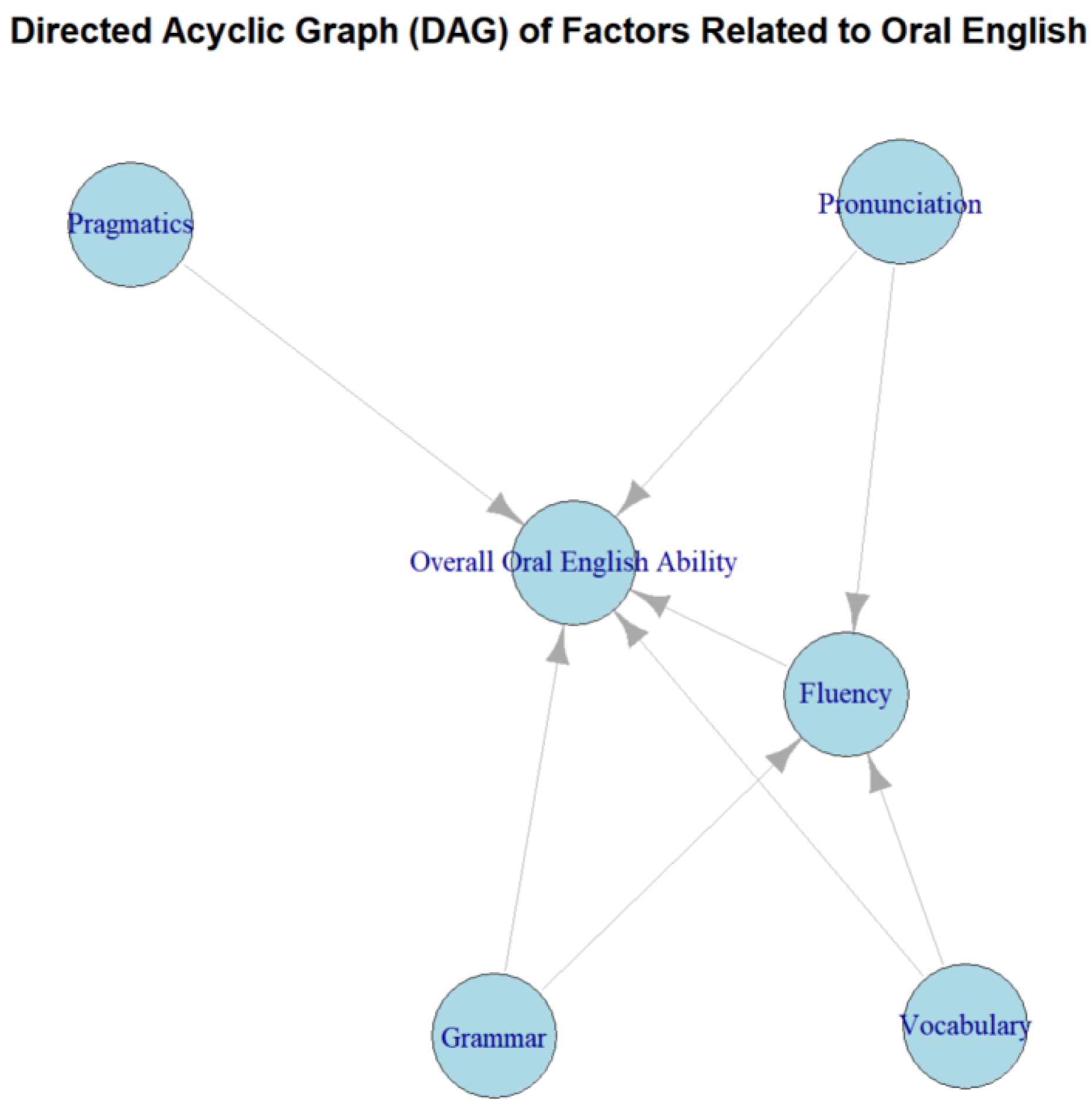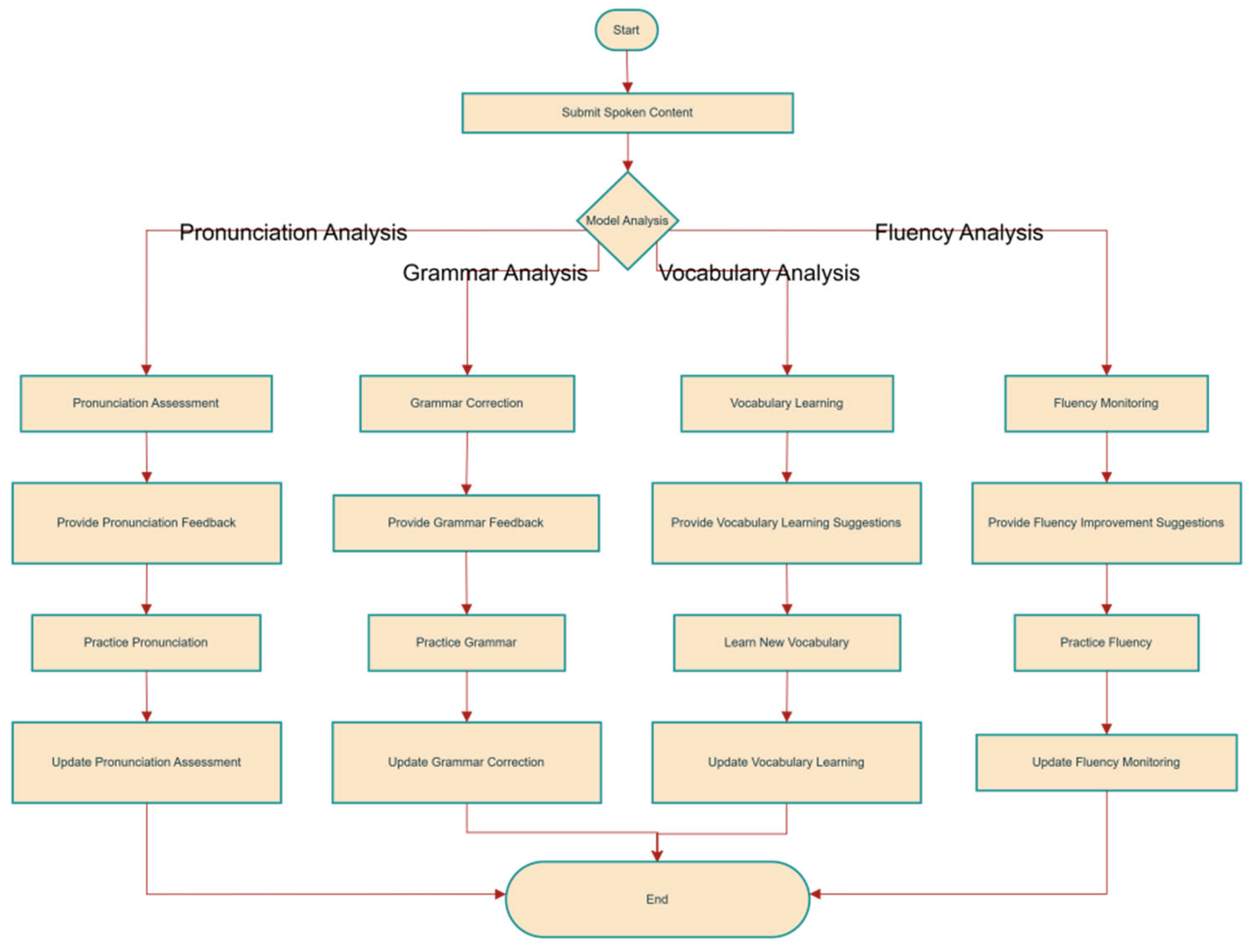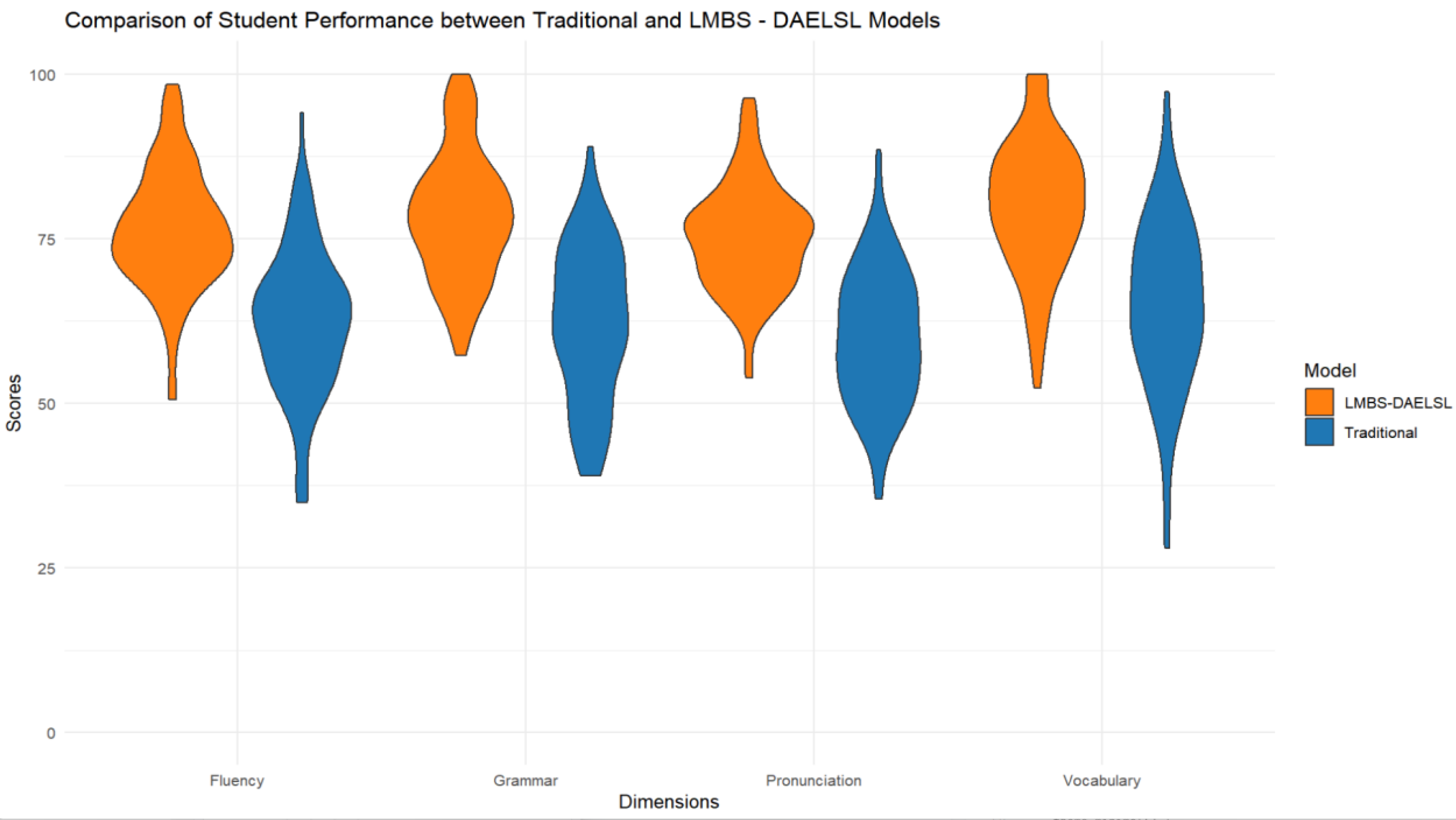1. Introduction
With the rapid development of large language models (LLMs), such as ChatGPT, their applications in education are increasingly prevalent. This study aims to transform the simple process of traditional single-semantic large models in oral practice and assessment of English, breaking through the limitations of basic oral practice. We focused on personalized improvement in professional English learning areas to overcome the bottleneck of traditional learning models. By integrating prior knowledge of oral skills, an LLM is trained to enhance undergraduate students’ oral proficiency [
1,
2].
In this study, we constructed an English oral knowledge base LLM based on multiple datasets, including Ministry of Education textbooks. We standardized the training correction and learning process to effectively improve the accuracy of oral assessment in pronunciation, grammar, vocabulary, and fluency. The developed English learning model in this study has ubiquitous characteristics to enhance learners’ enthusiasm and proficiency [
3,
4,
5].
2. Technical Literature
2.1. Bayesian Network
The Bayesian network is a graphical modeling tool based on probabilistic inference, with its theoretical foundation dating back to the early 1980s, proposed and refined by using artificial intelligence (AI). As an important branch of probabilistic graph models, dependencies between variables are presented by using directed acyclic graphs (DAGs) and conditional probability tables (CPTs). Nodes in the DAG represent random variables, and directed edges indicate the influence paths between variables; CPTs, on the other hand, detail the probability distributions of each node given its parent node’s state.
2.2. DAG
As the core component of Bayesian networks, DAGs visualize variable dependencies. Nodes represent specific variables, while directed edges indicate causal relationships between them. If there is a directed edge between the two nodes, the state of one node affects the other. The accompanying CPTs are used to draw a probability map for each node relative to its parent nodes to define the probability of each possible value of the current node given the state of its parent nodes. With this structure, the joint probability distribution of Bayesian networks is expressed as Equation (1).
where
is the node variable in the network, and
represents the set of parent nodes of the node
. This equation indicates that the joint probability of all variables is obtained by multiplying the local probability of each variable under its parent nodes.
3. LLM-DAELSL
3.1. Limitations of Traditional Oral Models
LLMs are built upon human language and vocabulary habits to predict subsequent words through the statistical probabilities of language and vocabulary. In natural language processing, especially in language learning, LLMs have inherent advantages, particularly in the probabilistic derivation of entire texts and the prediction and generation of subsequent texts [
6]. Generalized LLMs refer to language models with billions of (or more) parameters trained on vast amounts of text data. Traditional spoken language models are built on these generalized large models in the process shown in
Figure 1.
Due to the relatively open training model of traditional models, their convergence is not good, which makes professional English oral learning have poor adaptability to specific fields. The LLMs trained on general data cannot provide the most appropriate content. After inputting prompt words, insufficient relevant English context remains, making it difficult for learners to engage in immersive learning. The model overly relies on statistical probability derivation, lacking social and emotional attributes. The information density of language is insufficient, making it hard for learners to understand the other values and meanings behind the text [
7,
8].
3.2. Innovative Interaction Model
The core of the innovative interactive model developed in this study lies in leveraging expert databases and textbook resources to guide and train LLMs interactively, with real-time scenario generation. By integrating traditional knowledge and materials in oral English accumulated over many years of undergraduate education, the model supplements and trains on traditional semantic large models. Through multiple interactions and training, the model enhances the accuracy of undergraduate oral communication, making learning progressive and consistent with traditional methods (
Figure 2).
As shown in
Figure 2, the green modules of the system represent the innovative part of the model. Through temporal interaction, it demonstrates the dynamic association and step-by-step path between learners, large models, expert databases, and textbooks. Notably, the introduction of the red module-textbooks and resource modules allows learners to combine textbooks with traditional learning resources to correct pronunciation, grammar, and other aspects of spoken English. It also defines the essential content that English speakers in related undergraduate majors must master and effectively evaluates learning outcomes. The green module trains computers to better understand and generate text for specific directions to improve search engine fundamentals and make it easier for learners to find the required information. While traditional oral assessments are based on scores from experienced experts who are subject to human limitations, such as strong subjectivity and delayed feedback, LLM-DAELSL effectively avoids these issues, providing a more objective evaluation of relevant content [
9,
10].
3.3. Integration of Expert Database Design and Bayesian Network
In oral assessment, the expert database is a crucial component of the data in establishing a set of local oral assessment standards for large models for learners. The green module in
Figure 2 demonstrates a digital platform that integrates and screens expert information from multiple schools within their professional fields. Data collection, classification, storage, querying, and extraction enable the dynamic management of experts’ knowledge [
11,
12].
Bayesian networks are probabilistically established based on mathematical statistical standards for the derivation of conditional dependencies from a mathematical perspective. In the DAG network, each random variable is defined as a node. The key variables in oral learning (such as pronunciation, grammar, vocabulary, etc.) are graphically represented as various nodes, and the causal dependencies are shown through connections [
4] (
Figure 3).
By combining the DAG structure diagram, through pre-designed nodes related to oral factors for analysis, we simulated the learning paths of students interacting with LLM and expert databases. This simulation was combined with real-time interaction, LLM-DAELSL generation evaluation, and relevant learning resources. The learning resources were designed and developed from four dimensions. We also designed the database structure [
5,
8] for the learning resources (
Figure 4 and
Table 1).
4. Data Analysis and Outcomes
To validate the learning outcomes of language learners, two classes of the same grade were selected from Province J in China, consisting of students from the same grade and major. We compared the learning outcomes of traditional teaching models with those of LLM-DAELSL for six months. The scores in fluency, grammar, pronunciation, and vocabulary were compared. The results are presented in
Figure 5 and
Table 2.
All learners (in orange) showed better learning outcomes in four dimensions than the learning group with a traditional method (in blue). In terms of fluency and grammar, students with LLM-DAELSL showed a more concentrated distribution, with a significant improvement in median score. This reflected that the new model played a crucial role in long-term training. Additionally, the distributions for pronunciation and vocabulary were close due to the short experimental duration or limitations.
5. Conclusions
We constructed an English oral learning model for undergraduate students by integrating knowledge bases with teaching resources. An intelligent oral assessment and learning model was established based on deep LLMs. The model significantly enhanced in real-time evaluation accuracy, particularly in the dimensions of coherence and grammatical correctness in oral expression. However, the learning outcomes in pronunciation correction and vocabulary expansion were not enhanced significantly due to a short experimental period, insufficient precision in pronunciation corpus annotation, and inadequate coverage of vocabulary learning resources.
Future research is necessary to introduce acoustic models into English learning, train the oral pronunciation features of the system through feature analysis technology and establish a dynamic expert knowledge map for targeted purposes, integrate and iterate new knowledge models, and further improve the level of oral teaching.
Author Contributions
Conceptualization, J.Y. and H.B.B.; methodology, J.Y.; software, J.Y.; validation, J.Y. and H.B.B.; formal analysis, J.Y.; investigation, J.Y.; resources, J.Y.; data curation, J.Y.; writing—original draft preparation, J.Y.; writing—review and editing, J.Y.; visualization, J.Y.; supervision, J.Y.; project administration, J.Y.; funding acquisition, J.Y. All authors have read and agreed to the published version of the manuscript.
Funding
This research received no external funding.
Institutional Review Board Statement
Not applicable.
Informed Consent Statement
Informed consent was obtained from all subjects involved in the study.
Data Availability Statement
No new data were created or analyzed in this study. Data sharing is not applicable to this article.
Conflicts of Interest
The authors declare no conflict of interest.
References
- Arslan, B.; Nuhoglu, C.; Satici, M.O.; Altinbilek, E. Evaluating LLM-based generative AI tools in emergency triage: A comparative study of ChatGPT Plus, Copilot Pro, and triage nurses. Am. J. Emerg. Med. 2025, 89, 174–181. [Google Scholar] [CrossRef] [PubMed]
- Mahouachi, R.; Mahersia, H. Multilingual and Tunisian Dialect Analysis of Banking App Reviews Using LLMs. Expert Syst. Appl. 2025, 290, 128260. [Google Scholar] [CrossRef]
- Xu, W.; Luo, G.; Meng, W.; Zhai, X.; Zheng, K.; Wu, J.; Li, Y.; Xing, A.; Li, J.; Li, Z.; et al. MRAgent: An LLM-based automated agent for causal knowledge discovery in disease via Mendelian randomization. Brief. Bioinform. 2025, 26, bbaf140. [Google Scholar] [CrossRef] [PubMed]
- Huang, Z.; Peng, P.; Lu, F.; Zhang, H. An LLM-based method for quality information extraction from web text for crowd-sensing spatiotemporal data. Trans. GIS. 2025, 29, e13294. [Google Scholar] [CrossRef]
- Hung, K.F.; Lin, K.P. Advanced LLM prompt techniques to enhance nighttime object detection. J. Chin. Inst. Eng. 2025, 1–14. [Google Scholar] [CrossRef]
- Zhao, Y.; Zhang, R.; Li, W.; Li, L. Assessing and understanding creativity in large language models. Mach. Intell. Res. 2025, 22, 417–436. [Google Scholar] [CrossRef]
- Sawer, A.; Zhang, Y.; Das, T.; Christopher, H. Shaping AI education in imaging and harnessing learning opportunities: Initial perspectives from Radiology trainees. R. Coll. Radiol. Open 2025, 3, 100177. [Google Scholar] [CrossRef]
- Sun, Q.; Zhang, J.; Yu, Y. Exploring the Path of Digital Transformation in College English Teaching in Vocational Colleges. Stud. Lang. Cult. 2025, 33, 103–106. [Google Scholar]
- Hao, X. An empirical study on the comparative effects of online and offline peer interaction in English speaking teaching. Educ. Prog. 2025, 15, 1199–1204. [Google Scholar] [CrossRef]
- Yu, L. Research on teaching mode of critical thinking ability in college English based on AI. Presented at the 2025 Higher Education Teaching Seminar, Zhengzhou, China, 11 January 2025. (In Chinese). [Google Scholar]
- Jiang, W.; Tao, J.; Guan, Z. A trusted data privacy computing method for vehicular ad hoc networks based on homomorphic encryption and DAG blockchain. IEEE Internet Things J. 2024, 12, 6621–6632. [Google Scholar] [CrossRef]
- Song, X.; Li, S.; Chang, Y.; Zhang, C.; Li, Q. Performance analysis for DAG-based blockchain systems based on the Markov process. J. Syst. Sci. Syst. Eng. 2025, 34, 29–54. [Google Scholar] [CrossRef]
| Disclaimer/Publisher’s Note: The statements, opinions and data contained in all publications are solely those of the individual author(s) and contributor(s) and not of MDPI and/or the editor(s). MDPI and/or the editor(s) disclaim responsibility for any injury to people or property resulting from any ideas, methods, instructions or products referred to in the content. |
© 2025 by the authors. Licensee MDPI, Basel, Switzerland. This article is an open access article distributed under the terms and conditions of the Creative Commons Attribution (CC BY) license (https://creativecommons.org/licenses/by/4.0/).










